
List of GE locomotives
Encyclopedia
The following is a list of locomotive
s produced by GE Transportation Systems
. All were/are built at Erie, Pennsylvania
, in the United States
. Most (except the electrics, the switchers, the AC6000CW, and the Evolution series) are powered by various versions of GE's own FDL diesel prime mover, based on a Cooper Bessemer
design and manufactured at Grove City, Pennsylvania
.
s as "U-Boats".
in 1995, and the new railroad, Burlington Northern-Santa Fe (later BNSF Railway) furthered the practice.
Introduced during the Dash 8's later years were split-cooling in the radiators and electronic displays for the crews (instead of analogue gauges).
motors instead of the conventional DC versions. The cab air conditioner was moved from the left (conductor's) side walkway to a position under the cab floor to make space for the six traction inverters (one per axle) that supply the AC current to the traction motors.
locomotives replace the Dash 9 and AC series in North America and exceed the new U.S. EPA
Tier II emissions standards that took effect in 2005, reducing nitrogen oxides emissions by over 40% and improving fuel consumption as well. They use the new GEVO engine (based in part on the 7HDL design) which produces the same power from twelve cylinders as previous locomotives' 16-cylinder 7FDL engine. Both AC and DC Evolution Series share the same carbody design. The radiator "wings" are even larger than those of the Dash 9 and AC series. Like those on the AC6000CW, they extend past the end of the long hood. Unlike any previous GE locomotive type underside of the wings are divided into two sections with different angles.
to replace the aging EMD F40PH
. Additional units have been built for Via Rail Canada.
Locomotive
A locomotive is a railway vehicle that provides the motive power for a train. The word originates from the Latin loco – "from a place", ablative of locus, "place" + Medieval Latin motivus, "causing motion", and is a shortened form of the term locomotive engine, first used in the early 19th...
s produced by GE Transportation Systems
GE Transportation Systems
GE Transportation, formerly known as GE Rail, is a division of General Electric. The organization manufactures equipment for the railroad, marine, mining, drilling and energy generation industries. It is based in Erie, Pennsylvania. Locomotives are assembled at the Erie plant, while engine...
. All were/are built at Erie, Pennsylvania
Erie, Pennsylvania
Erie is a city located in northwestern Pennsylvania in the United States. Named for the lake and the Native American tribe that resided along its southern shore, Erie is the state's fourth-largest city , with a population of 102,000...
, in the United States
United States
The United States of America is a federal constitutional republic comprising fifty states and a federal district...
. Most (except the electrics, the switchers, the AC6000CW, and the Evolution series) are powered by various versions of GE's own FDL diesel prime mover, based on a Cooper Bessemer
Cooper Bessemer
Cooper-Bessemer refers to the Cooper-Bessemer Corporation and the Cooper-Bessemer brand of industrial engines and compressors, manufactured in Mount Vernon, Ohio....
design and manufactured at Grove City, Pennsylvania
Grove City, Pennsylvania
Grove City is a borough in Mercer County, Pennsylvania, approximately north of Pittsburgh. It is the home of Grove City College, a private conservative Christian liberal arts college; General Electric; Instron; USIS; George G. Howe Co.; and a number of small businesses. It is also the home to...
.
Switchers
| Model designation | Build year | Total produced | AAR wheel arrangement AAR wheel arrangement The AAR wheel arrangement system is a method of classifying locomotive wheel arrangements that was developed by the Association of American Railroads. It is essentially a simplification of the European UIC classification, and it is widely used in North America to describe diesel and electric... | Prime mover Prime mover (locomotive) In engineering, a prime mover is an engine that converts fuel to useful work. In locomotives, the prime mover is thus the source of power for its propulsion. The term is generally used when discussing any locomotive powered by an internal combustion engine... | |Power output Horsepower Horsepower is the name of several units of measurement of power. The most common definitions equal between 735.5 and 750 watts.Horsepower was originally defined to compare the output of steam engines with the power of draft horses in continuous operation. The unit was widely adopted to measure the... | 20-ton Boxcab | 1938 | 5 | B | Cummins | 150 hp |
|---|---|---|---|---|---|---|
| 23-ton Boxcab | 1939 | 6 | B | Cummins | 150 hp | |
| 23-ton | 1941 | 29 | B | Cummins | 150 hp |  |
| 25-ton | 1941–1974 | 510 | B | Cummins | 150 hp | |
| 35-ton | B | |||||
| 43-ton | B-B | |||||
| 44-ton GE 44-ton switcher The GE 44-ton switcher is a 4-axle diesel locomotive built by General Electric between 1940 and 1956. It was designed for industrial and light switching duties, often replacing steam locomotives that had previously been assigned these chores... |
1940–1956 | 385 | B-B | Caterpillar Caterpillar Inc. Caterpillar Inc. , also known as "CAT", designs, manufactures, markets and sells machinery and engines and sells financial products and insurance to customers via a worldwide dealer network. Caterpillar is the world's largest manufacturer of construction and mining equipment, diesel and natural gas... D17000 × 2 (most) Hercules DFXD × 2 (11) Buda 6DH1742 × 2 (10) Caterpillar D342 × 2 (last 4) |
380 hp | 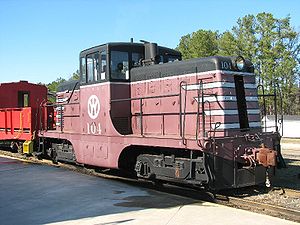 |
| 45-ton GE 45-ton switcher The GE 45-ton switcher is a 4-axle diesel locomotive built by GE between 1940 and 1956.-Equipment:The locomotive was equipped with two Cummins diesel engines, each driving a generator which, in turn, drove one of the two traction motors, one per truck. In early models, the second axle on each... |
1940–1956 | B-B | Cummins × 2 | 300 hp hp Horsepower Horsepower is the name of several units of measurement of power. The most common definitions equal between 735.5 and 750 watts.Horsepower was originally defined to compare the output of steam engines with the power of draft horses in continuous operation. The unit was widely adopted to measure the... |
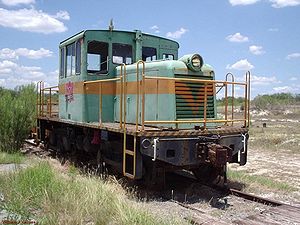 |
|
| GE 45-Ton switcher "Drop Cab" | 1944–1949 | 103 | B-B | |||
| GE 45-Ton switcher "Off-Center Cab" | 1941 | 9 | B-B | Cooper Bessemer EN6 | ||
| GE 46-Ton switcher "Drop Cab" | 1955 | 3 | B-B | |||
| 47-ton "Drop Cab" | 1943–1953 | 58 | B-B | |||
| 50-ton | B-B | |||||
| GE 55-Ton switcher "Off-Center Cab" | 1931 | 7 | B-B | Ingersoll Rand 300 | ||
| GE 57-Ton switcher "Off-Center Cab" | 1935 | 1 | B-B | Cooper Bessemer ENL6 | ||
| 60-ton "Boxcab" GE boxcab The GE boxcabs were diesel-electric switcher locomotives. General Electric built the chassis and running gear, generator, motors and controls, and Ingersoll Rand provided the diesel engine... |
1928–1930 | 2 | B-B | Ingersoll Rand 300 | ||
| 60-ton "Off-Center Cab" | 1935–1941 | 10 | B-B | Ingersoll Rand 300 (1) Ingersoll Rand 400 (2) Cooper Bessemer EN8 (3) Cooper Bessemer ENL8 (4) | ||
| GE 61-Ton switcher "Off-Center Cab" | 1937 | 1 | B-B | Cooper Bessemer EN6 | ||
| 65-ton | B-B | |||||
| GE 68-Ton switcher "Off-Center Cab" | 1939 | 2 | B-B | Cooper Bessemer GN6 | ||
| 70-ton GE 70-ton switcher The GE 70-ton switcher is a 4-axle diesel locomotive built by General Electric between about 1942 and 1955. It is classified as a B-B type locomotive. The first series of "70 tonners" were a group of seven center cab locomotives built for the New York Central Railroad in November, 1942. These... |
1947-1955 | 238 | B-B | Cooper-Bessemer FWL-6T | 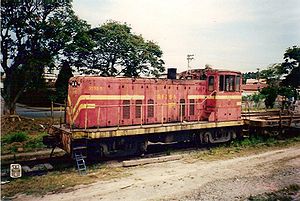 |
|
| GE 78-ton | 1953 | 10 | B-B | ALCO 6-251A | 800 hp | Consolidated Railroads of Cuba |
| 80-ton GE 80-ton switcher The GE 80-ton switcher is a locomotive model built by GE Transportation Systems. It is classified as a B-B type locomotive. It was designed for industrial and light switching duties around railheads and ports.- Military version :... |
B-B |  |
||||
| 95-ton | B-B | |||||
| 100-ton "Boxcab" GE boxcab The GE boxcabs were diesel-electric switcher locomotives. General Electric built the chassis and running gear, generator, motors and controls, and Ingersoll Rand provided the diesel engine... |
1928–1930 | 11 | B-B | Ingersoll Rand 300(x2) | ||
| 100-ton | 1933–1935 | 7 | B-B | Ingersoll Rand 300(x2) | ||
| 110-ton GE 110-ton switcher The GE 110-ton switcher is a locomotive model built by GE Transportation Systems. It was intended for use in light switching duties.- External links :*... |
B-B | |||||
| 125-ton | B-B | |||||
| 126-ton | B-B | |||||
| 128-ton | B-B | |||||
| 600-hp center-cab | 1933–1935 | 7 | B-B | Ingersoll-Rand 10×12 | 600 hp | |
| NH class DEY-2 | 1936–1937 | 10 | B-B | Cooper-Bessemer 10½×12 GN8 (5) Ingersoll-Rand 10×12 600 (5) |
600 hp | |
| 1000-hp center-cab | 1937–1940 | 9 | B-B | Cooper-Bessemer GN-6 | 1000 hp | |
| SG10B South African Class 36-000 Between June 1975 and 1981 the South African Railways placed one hundred and twenty-four Class 36-000 GE SG10B diesel-electric locomotives in service.-Manufacturer:... |
1975–1981 | 124 | B-B | 7FDL-8 | 1100 hp |
General purpose
| Model designation | Build year | Total produced | AAR wheel arrangement AAR wheel arrangement The AAR wheel arrangement system is a method of classifying locomotive wheel arrangements that was developed by the Association of American Railroads. It is essentially a simplification of the European UIC classification, and it is widely used in North America to describe diesel and electric... | Prime mover Prime mover (locomotive) In engineering, a prime mover is an engine that converts fuel to useful work. In locomotives, the prime mover is thus the source of power for its propulsion. The term is generally used when discussing any locomotive powered by an internal combustion engine... | |Power output Horsepower Horsepower is the name of several units of measurement of power. The most common definitions equal between 735.5 and 750 watts.Horsepower was originally defined to compare the output of steam engines with the power of draft horses in continuous operation. The unit was widely adopted to measure the... | 57-ton gas-electric boxcab GE 57-ton gas-electric boxcab Before Diesel engines had been perfected in the early 1900s, many companies chose to use the gasoline engine for rail motive power. The first GE Locomotive was a series of four-axle boxcab gasoline-electric machines closely related to their "doodlebugs", a line of self-propelled passenger cars... |
1913 | B-B | 2 x GM-16C4 V-8 |
|---|---|---|---|---|---|---|
| 60-ton demonstrator | B-B | Ingersoll-Rand | 300 hp | |||
| 60-ton boxcab | B-B | Ingersoll-Rand | 300 hp | |||
| 100-ton boxcab | B-B | 2x Ingersoll-Rand | 600 hp | |||
| EN-6 | B-B | |||||
| 1800-hp transfer | 1936 | 1 | C-C | 2x Ingersoll-Rand | 1800 hp | |
| 2000-hp transfer | 1936 | 1 | C-C | Busch-Sulzer | 2000 hp | |
| U6B | B-B | |||||
| UM20B | 1954 | 2 ( 1 ea cab and booster) | B-B | CB 8 cyl | 1200 hp | |
| UM20B | 1954 | 2 ( 1 ea cab and booster) | B-B | CB 12 cyl | 1800 hp | |
| GE GEX3341 | 1954–1966 | 11 White Pass and Yukon Route White Pass and Yukon Route The White Pass and Yukon Route is a Canadian and U.S. Class II narrow gauge railroad linking the port of Skagway, Alaska, with Whitehorse, the capital of Yukon. An isolated system, it has no direct connection to any other railroad. Equipment, freight and passengers are ferried by ship through the... |
C-C | ALCO American Locomotive Company The American Locomotive Company, often shortened to ALCO or Alco , was a builder of railroad locomotives in the United States.-Early history:... 6-251 |
930 hp | 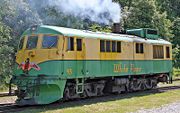 |
Universal Series (1956 to 1998)
Because their model designations start with "U", they are known colloquially to railfanRailfan
A railfan or rail buff , railway enthusiast or railway buff , or trainspotter , is a person interested in a recreational capacity in rail transport...
s as "U-Boats".
Four axles
| Model designation | Build year | Total produced | AAR wheel arrangement AAR wheel arrangement The AAR wheel arrangement system is a method of classifying locomotive wheel arrangements that was developed by the Association of American Railroads. It is essentially a simplification of the European UIC classification, and it is widely used in North America to describe diesel and electric... | Prime mover Prime mover (locomotive) In engineering, a prime mover is an engine that converts fuel to useful work. In locomotives, the prime mover is thus the source of power for its propulsion. The term is generally used when discussing any locomotive powered by an internal combustion engine... | |Power output Horsepower Horsepower is the name of several units of measurement of power. The most common definitions equal between 735.5 and 750 watts.Horsepower was originally defined to compare the output of steam engines with the power of draft horses in continuous operation. The unit was widely adopted to measure the... | UM6B | 1973 | 20 | B-B | Caterpillar D-379 | 700 hp | >- align = "center" | U9B | 1957 | 13 | B-B | CB. FWL 6T | 1060 hp | >- align = "center" | U10B | B-B | >- align = "center" | UM10B | 1973 | B-B | Caterpillar D398B | 1050 hp | U11B | 1980 | B-B | Caterpillar D388 & D389 | >- align = "center" | U12B South African Class 31-000 In June and July 1958 the South African Railways placed forty-five Class 31-000 GE U12B diesel-electric locomotives in service.- Manufacturer :... |
1958 | 45 (SAR) | B-B | CB FVBL-8 | 1200 hp | >- align = "center" | U13B | B-B | >- align = "center" | UD18 | 1956 | 10 | B-B | GE FDL-12 | 1800 hp | >- align = "center" | U18B GE U18B The GE U18B Diesel-electric locomotive was introduced by GE Transportation as a branch line roadswitcher in 1973.Easy to spot due to its relatively short length — 54 ft 8 in — it was the only North American locomotive powered by the 8-cylinder 7FDL engine.The Seaboard Coast... |
1973-76 | 163 | B-B | GE 7FDL-8 | 1800 hp | 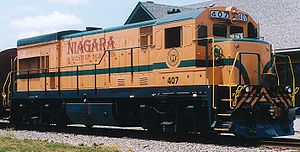 >- align = "center"
>- align = "center" |
U23B GE U23B The GE U23B Diesel-electric locomotive was introduced by GE Transportation in 1968 as a medium horsepower roadswitcher, featuring a 12 cylinder FDL engine. It was one of the most successful models of the Universal Series, with railroads ordering it from 1968 until 1977 when it was replaced by the... |
1968-77 | 481 | B-B | GE 7FDL-12 | 2350 hp | 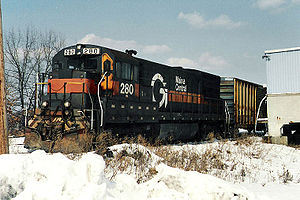 >- align = "center"
>- align = "center" |
U25B GE U25B The GE U25B was General Electric's first independent entry into the United States domestic diesel-electric railroad locomotive market for heavy production road locomotives since 1936... |
1959-66 | 478 | B-B | GE FDL-16 | 2500 hp |  >- align = "center"
>- align = "center" |
U28B GE U28B The GE U28B diesel locomotive model replaced the U25B in early 1966, featuring a slightly uprated prime mover . Early units had the same carbody styling as the U25B, while later units had design features more in common with later models... |
1966 | 148 | B-B | GE FDL-16 | 2800 hp | 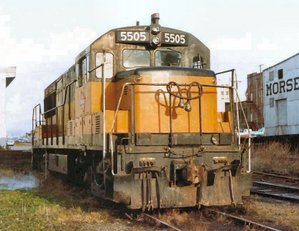 >- align = "center"
>- align = "center" |
U30B GE U30B General Electric's U30B was a further development of the U28B locomotive, with a 3000 horsepower 16-cylinder prime mover. It remained in production for over eight years. The U30B competed with the EMD GP40 and the ALCO Century 430, but was not as successful at the GE U30C.-External links:*... |
1966-75 | 296 | B-B | GE FDL-16 | 3000 hp (2240 kW) |
 >- align = "center"
>- align = "center" |
U33B GE U33B The GE U33B diesel locomotive model was offered by GE in 1966, featuring a 16 cylinder motor. It is 60 ft 2 in long.-Original Owners:-External links:* Sarberenyi, Robert. .... |
1966-75 | 137 | B-B | GE FDL-16 | 3300 hp | >- align = "center" | U36B GE U36B GE U36B was a diesel locomotive produced by General Electric beginning in 1969. The U36B was GE's 3600 horsepower answer to the power race with EMD. Only 3 railroads bought this locomotive.-History:... |
1969-74 | 125 | B-B | GE FDL-16 | 3600 hp | >- align = "center" | MATE | 1971-72 | 25 | B-B | none | Road Slug Slug (railroad) A railroad slug is an accessory to a diesel-electric locomotive. It has trucks with traction motors but is unable to move about under its own power, as it does not contain a prime mover to produce electricity... |
|---|
Six axles
| Model designation | Build year | Total produced | AAR wheel arrangement AAR wheel arrangement The AAR wheel arrangement system is a method of classifying locomotive wheel arrangements that was developed by the Association of American Railroads. It is essentially a simplification of the European UIC classification, and it is widely used in North America to describe diesel and electric... | Prime mover Prime mover (locomotive) In engineering, a prime mover is an engine that converts fuel to useful work. In locomotives, the prime mover is thus the source of power for its propulsion. The term is generally used when discussing any locomotive powered by an internal combustion engine... | |Power output Horsepower Horsepower is the name of several units of measurement of power. The most common definitions equal between 735.5 and 750 watts.Horsepower was originally defined to compare the output of steam engines with the power of draft horses in continuous operation. The unit was widely adopted to measure the... | U12C | C-C | |||||||||||||||||||||||||||||||||||||||||||||||||||||||||||||||||||||
|---|---|---|---|---|---|---|---|---|---|---|---|---|---|---|---|---|---|---|---|---|---|---|---|---|---|---|---|---|---|---|---|---|---|---|---|---|---|---|---|---|---|---|---|---|---|---|---|---|---|---|---|---|---|---|---|---|---|---|---|---|---|---|---|---|---|---|---|---|---|---|---|---|---|---|---|---|
| UM12C | 1964 | 50 State Railway of Thailand State Railway of Thailand The State Railway of Thailand is the state-owned rail operator in Thailand. The network sees around 50 million passengers per annum.-History:SRT was founded as the Royal State Railways of Siam in 1890... |
C-C | Cummins KT38-L | 1320 hp | >- align = "center" | U13C | C-C | >- align = "center" | U14C | C-C | >- align = "center" | U15C South African Class 35-000 Between March 1972 and May 1973 the South African Railways placed seventy Class 35-000 GE U15C diesel-electric locomotives in service.- Manufacturer :... |
1972–1980 | 170 (SAR) | C-C | GE 7FDL-8 | 1160 kW | ||||||||||||||||||||||||||||||||||||||||||||||||||||||||||
| U17C GE U17C The GE U17C Diesel-electric locomotive was introduced by GE Transportation as an export model roadswitcher in 1973.Easy to spot due to its relatively short length — 52 ft 9 in — it was powered by the 8-cylinder FDL-8T engine.... |
1973–1981 | C-C | GE 7FDL-8 | 1700 hp | U18C | 1976–1998 | 92 (PT. KAI) | C-C | GE 7FDL-8 | 1825 hp | U20C GE U20C The GE U20C Diesel-electric locomotive was introduced by GE Transportation Systems as an export model roadswitcher in 1964. It was powered by the 8-cylinder FDL-8T engine.[1]... |
1995–2005 | 984, 41. (PT KAI) | C-C | GE 7FDL-8 | 2000 hp | U23C GE U23C The 2300 horsepower GE U23C diesel locomotive model was first offered by GE in 1968, and featured a V-type 12 cylinder version of the standard GE FDL diesel motor. Designed as a competitor to EMD's SD38 and SD39 series, it was intended for heavy transfer, drag and hump service where speed was not... |
1968-70 | 223 | C-C | GE FDL-12 | 2,250 hp Horsepower Horsepower is the name of several units of measurement of power. The most common definitions equal between 735.5 and 750 watts.Horsepower was originally defined to compare the output of steam engines with the power of draft horses in continuous operation. The unit was widely adopted to measure the... (1,680 kW) |
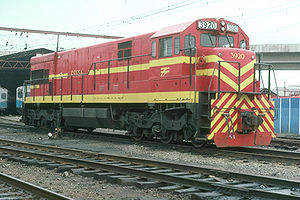 >- align = "center"
>- align = "center" |
U25C GE U25C The U25C was General Electric's first six-axle road switcher intended for the United States domestic market. Launched in September 1963, it remained in production until December 1965. It was replaced by the U28C.-External links:* Sarberenyi, Robert. ... |
1963-65 | 113 | C-C | GE FDL-16 | 2,500 hp Horsepower Horsepower is the name of several units of measurement of power. The most common definitions equal between 735.5 and 750 watts.Horsepower was originally defined to compare the output of steam engines with the power of draft horses in continuous operation. The unit was widely adopted to measure the... (1,860 kW) |
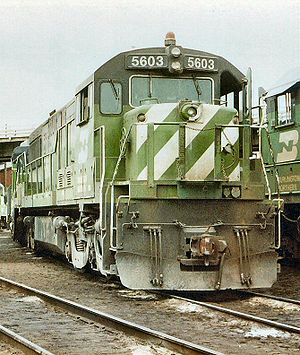 >- align = "center"
>- align = "center" |
U26C GE U26C The GE U26C diesel locomotive model was introduced by GE Transportation Systems in 1971. All examples of this model are six axle units, and have the wheel arrangement C-C or Co'Co' .... |
1971-87 | 294 (SAR) 49 (NZR) 36 (Kenya) 6 (Brazil) |
C-C | GE FDL-12 | 2,750 hp Horsepower Horsepower is the name of several units of measurement of power. The most common definitions equal between 735.5 and 750 watts.Horsepower was originally defined to compare the output of steam engines with the power of draft horses in continuous operation. The unit was widely adopted to measure the... (2,050 kW) |
 >- align = "center"
>- align = "center" |
U28C GE U28C The U28C was developed by General Electric from the U25C, with a slight increase in power of 300 hp . A passenger-hauling variant, the U28CG, was also produced for the Atchison, Topeka and Santa Fe Railway.-External links:* Sarberenyi, Robert. ... |
1965-66 | 71 | C-C | GE FDL-16 | 2,800 hp (2,090 kW) |
>- align = "center" | U30C GE U30C The GE U30C was one of the earliest successes from General Electric in the diesel locomotive market. With 600 units sold, the U30C proved to be a choice for customers who weren't able to purchase SD40's or SD40-2's from EMD due to mass orders... |
1966-76 | 600 | C-C | GE FDL-16 | 3,000 hp (2,240 kW) |
 >- align = "center"
>- align = "center" |
U33C GE U33C The GE U33C is a 6-axle diesel locomotive built by GE Transportation Systems between 1968 and 1975. 375 examples of this locomotive were built for North American railroads.-Original Owners:-External links:* Thompson, J. David. .... |
1968-75 | 375 | C-C | GE FDL-16 | 3,300 hp Horsepower Horsepower is the name of several units of measurement of power. The most common definitions equal between 735.5 and 750 watts.Horsepower was originally defined to compare the output of steam engines with the power of draft horses in continuous operation. The unit was widely adopted to measure the... (2,460 kW) |
>- align = "center" | U36C GE U36C The GE U36C was a 3600 hp diesel-electric locomotive model built by GE Transportation Systems.The length of the locomotive was 67'3", standard for U30C, U33C, U34CH, U36C, U36CG, C30-7 and C36-7. The U36C also had steel capped pistons.... |
1971-75 | 218 | C-C | GE FDL-16 | 3600 hp | >- align = "center" | U50C GE U50C The GE U50C was a 5,000 hp diesel locomotive built by GE Transportation Systems. They were twin-engined locomotives, combining two 2,500 hp diesel engines.... |
1969-71 | 40 | C-C | Dual GE FDL-12 |
5,000 hp Horsepower Horsepower is the name of several units of measurement of power. The most common definitions equal between 735.5 and 750 watts.Horsepower was originally defined to compare the output of steam engines with the power of draft horses in continuous operation. The unit was widely adopted to measure the... (3,700 kW) |
Six axles & Pony
| Model designation | Build year | Total produced | AAR wheel arrangement AAR wheel arrangement The AAR wheel arrangement system is a method of classifying locomotive wheel arrangements that was developed by the Association of American Railroads. It is essentially a simplification of the European UIC classification, and it is widely used in North America to describe diesel and electric... | Prime mover Prime mover (locomotive) In engineering, a prime mover is an engine that converts fuel to useful work. In locomotives, the prime mover is thus the source of power for its propulsion. The term is generally used when discussing any locomotive powered by an internal combustion engine... | |Power output Horsepower Horsepower is the name of several units of measurement of power. The most common definitions equal between 735.5 and 750 watts.Horsepower was originally defined to compare the output of steam engines with the power of draft horses in continuous operation. The unit was widely adopted to measure the... | U18C1 South African Class 32-000 Between November 1959 and November 1961 the South African Railways placed one hundred and fifteen Class 32-000 GE U18C1 diesel-electric locomotives in service in South West Africa.- Manufacturer :... |
1959–1961 | 115 (SAR) | 1C-C1 | CB FVBL-12 | 2150 hp | >- align = "center" | U20C1 South African Class 32-200 In June and July 1966 the South African Railways placed ten Class 32-200 GE U20C1 diesel-electric locomotives in service in South West Africa..- Manufacturer :... |
1966 | 10 (SAR) | 1C-C1 | GE 7FDL-12 | 2150 hp |
|---|
Eight axles
| Model designation | Build year | Total produced | AAR wheel arrangement AAR wheel arrangement The AAR wheel arrangement system is a method of classifying locomotive wheel arrangements that was developed by the Association of American Railroads. It is essentially a simplification of the European UIC classification, and it is widely used in North America to describe diesel and electric... | Prime mover Prime mover (locomotive) In engineering, a prime mover is an engine that converts fuel to useful work. In locomotives, the prime mover is thus the source of power for its propulsion. The term is generally used when discussing any locomotive powered by an internal combustion engine... | |Power output Horsepower Horsepower is the name of several units of measurement of power. The most common definitions equal between 735.5 and 750 watts.Horsepower was originally defined to compare the output of steam engines with the power of draft horses in continuous operation. The unit was widely adopted to measure the... | U50 GE U50 The GE U50 was an eight-axle, diesel locomotive built by GE Transportation Systems. They were twin-engined locomotives, combining two 2,500 hp diesel engines.-Configuration:... |
1963-65 | 26 | B+B-B+B | Dual GE FDL-16 |
5,000 hp Horsepower Horsepower is the name of several units of measurement of power. The most common definitions equal between 735.5 and 750 watts.Horsepower was originally defined to compare the output of steam engines with the power of draft horses in continuous operation. The unit was widely adopted to measure the... (3,700 kW) |
|---|
Dash-7 Series (introduced 1977)
Models with "A" suffix are equipped with 12-cylinder prime mover in place of the standard 16 cylinder version, with the same power output.Four axles
| Model designation | Build year | Total produced | AAR wheel arrangement AAR wheel arrangement The AAR wheel arrangement system is a method of classifying locomotive wheel arrangements that was developed by the Association of American Railroads. It is essentially a simplification of the European UIC classification, and it is widely used in North America to describe diesel and electric... | Prime mover Prime mover (locomotive) In engineering, a prime mover is an engine that converts fuel to useful work. In locomotives, the prime mover is thus the source of power for its propulsion. The term is generally used when discussing any locomotive powered by an internal combustion engine... | |Power output Horsepower Horsepower is the name of several units of measurement of power. The most common definitions equal between 735.5 and 750 watts.Horsepower was originally defined to compare the output of steam engines with the power of draft horses in continuous operation. The unit was widely adopted to measure the... | B23-7 GE B23-7 The GE B23-7 is a diesel locomotive model that was offered first by GE in 1977, featuring a 12 cylinder engine. It is 61 ft 2 in long. It competed with the EMD GP38-2. General Electric also produced a variant, the BQ23-7, for the Seaboard Coast Line.Ten Ferrocarriles Nacionales de México... |
1977-84 | 536 | B-B | GE 7FDL-12 | 2,250 hp Horsepower Horsepower is the name of several units of measurement of power. The most common definitions equal between 735.5 and 750 watts.Horsepower was originally defined to compare the output of steam engines with the power of draft horses in continuous operation. The unit was widely adopted to measure the... (1,678 kW) |
 >- align = "center"
>- align = "center" |
BQ23-7 GE BQ23-7 The GE BQ23-7 was a model of diesel locomotive manufactured by General Electric, a variant of the B23-7 built between 1978 and 1979 . Identical to a regular B23-7, but equipped with an enlarged operating cab for accommodating the train crew, thus making a case for eliminating the caboose from the... |
1978-79 | 10 | B-B | GE 7FDL-12 | 2,250 hp Horsepower Horsepower is the name of several units of measurement of power. The most common definitions equal between 735.5 and 750 watts.Horsepower was originally defined to compare the output of steam engines with the power of draft horses in continuous operation. The unit was widely adopted to measure the... (1,678 kW) |
>- align = "center" | B30-7 GE B30-7 The GE B30-7 diesel locomotive model was offered first by GE in 1977, featuring a 16 cylinder motor. It is 61 ft 2 in long. A change to the original B30-7 was using the 12 cylinder FDL rated at 3000 horsepower, resulting in a B30-7A, B30-7A1 and a cabless B30-7A .B30-7As were built... |
1977-82 | 279 | B-B | GE 7FDL-16 | 3,000 hp Horsepower Horsepower is the name of several units of measurement of power. The most common definitions equal between 735.5 and 750 watts.Horsepower was originally defined to compare the output of steam engines with the power of draft horses in continuous operation. The unit was widely adopted to measure the... (2,238 kW) |
 >- align = "center"
>- align = "center" |
B30-7A GE B30-7 The GE B30-7 diesel locomotive model was offered first by GE in 1977, featuring a 16 cylinder motor. It is 61 ft 2 in long. A change to the original B30-7 was using the 12 cylinder FDL rated at 3000 horsepower, resulting in a B30-7A, B30-7A1 and a cabless B30-7A .B30-7As were built... |
1980-82 | 58 | B-B | GE 7FDL-12 | 3,000 hp Horsepower Horsepower is the name of several units of measurement of power. The most common definitions equal between 735.5 and 750 watts.Horsepower was originally defined to compare the output of steam engines with the power of draft horses in continuous operation. The unit was widely adopted to measure the... (2,238 kW) |
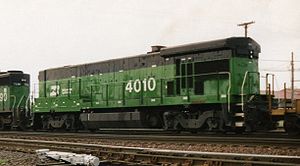 >- align = "center"
>- align = "center" |
B36-7 GE B36-7 The GE B36-7 is a 4-axle diesel locomotive built by GE Transportation Systems between 1980 and 1985. 222 examples of this locomotive were built for North American railroads and eight units were built for a Columbian coal mining operation. The units were designed as successors to GE's U36B's... |
1980-85 | 230 | B-B | GE 7FDL-16 | 3,600 hp Horsepower Horsepower is the name of several units of measurement of power. The most common definitions equal between 735.5 and 750 watts.Horsepower was originally defined to compare the output of steam engines with the power of draft horses in continuous operation. The unit was widely adopted to measure the... (2,685 kW) |
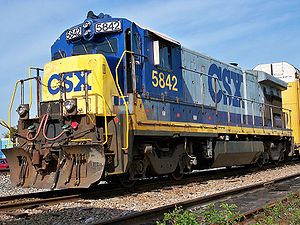 |
|---|
Six axles
| Model designation | Build year | Total produced | AAR wheel arrangement AAR wheel arrangement The AAR wheel arrangement system is a method of classifying locomotive wheel arrangements that was developed by the Association of American Railroads. It is essentially a simplification of the European UIC classification, and it is widely used in North America to describe diesel and electric... | Prime mover Prime mover (locomotive) In engineering, a prime mover is an engine that converts fuel to useful work. In locomotives, the prime mover is thus the source of power for its propulsion. The term is generally used when discussing any locomotive powered by an internal combustion engine... | |Power output Horsepower Horsepower is the name of several units of measurement of power. The most common definitions equal between 735.5 and 750 watts.Horsepower was originally defined to compare the output of steam engines with the power of draft horses in continuous operation. The unit was widely adopted to measure the... | C18-7i | 1993 | 10 | C-C | GE 7FDL-8 | 1,800 hp Horsepower Horsepower is the name of several units of measurement of power. The most common definitions equal between 735.5 and 750 watts.Horsepower was originally defined to compare the output of steam engines with the power of draft horses in continuous operation. The unit was widely adopted to measure the... ( kW) |
>- align = "center" | C30-7 GE C30-7 The GE C30-7 is a 6-axle diesel locomotive built by GE Transportation Systems between 1976 and 1986 as an updated U30C. It is powered by a 16-cylinder, FDL-series diesel engine. 1,137 examples of this locomotive were built for North American railroads.... |
1976-85 | 1,087 | C-C | GE 7FDL-16 | 3,000 hp Horsepower Horsepower is the name of several units of measurement of power. The most common definitions equal between 735.5 and 750 watts.Horsepower was originally defined to compare the output of steam engines with the power of draft horses in continuous operation. The unit was widely adopted to measure the... (2,238 kW) |
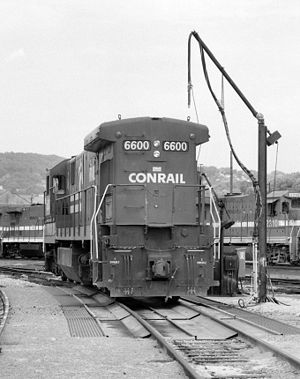 >- align = "center"
>- align = "center" |
C30-7A | 1984-90 | 57 | C-C | GE 7FDL-12 | 3,000 hp Horsepower Horsepower is the name of several units of measurement of power. The most common definitions equal between 735.5 and 750 watts.Horsepower was originally defined to compare the output of steam engines with the power of draft horses in continuous operation. The unit was widely adopted to measure the... (2,238 kW) |
>- align = "center" | C36-7 GE C36-7 The GE C36-7 is a 6-axle diesel locomotive built by GE Transportation Systems and GE do Brasil between 1978 and 1989. 599 examples of this locomotive were built, 422 of which were exported to the People's Republic of China, which designated it ND5... (China Railways ND5} |
1978-85 | 599 | C-C | GE 7FDL-16 | 3,600 hp Horsepower Horsepower is the name of several units of measurement of power. The most common definitions equal between 735.5 and 750 watts.Horsepower was originally defined to compare the output of steam engines with the power of draft horses in continuous operation. The unit was widely adopted to measure the... (2,685 kW) |
|---|
Dash-8 Series (introduced mid-1980s)
GE's originally introduced this series with model designation following the pattern of the Dash-7 line. After product improvements were made to the line in 1987 the official designations for models in this series changed to "Dash-8...", as shown in the list below. However, for simplicity, many railroads decided to use designations which follow the pattern of the Dash-7 line. Thus, for example, the Dash 8-40C is usually rendered as "C40-8". The "W" suffix indicates the then-optional wide-nose "North American" safety cab. For example, the Santa Fe used the designation "B40-8W" for GE's "Dash 8-40BW". The railroad continued this practice until its merger with the Burlington Northern RailroadBurlington Northern Railroad
The Burlington Northern Railroad was a United States-based railroad company formed from a merger of four major U.S. railroads. Burlington Northern operated between 1970 and 1996....
in 1995, and the new railroad, Burlington Northern-Santa Fe (later BNSF Railway) furthered the practice.
Introduced during the Dash 8's later years were split-cooling in the radiators and electronic displays for the crews (instead of analogue gauges).
Four axles
| Model designation | Build year | Total produced | AAR wheel arrangement AAR wheel arrangement The AAR wheel arrangement system is a method of classifying locomotive wheel arrangements that was developed by the Association of American Railroads. It is essentially a simplification of the European UIC classification, and it is widely used in North America to describe diesel and electric... | Prime mover Prime mover (locomotive) In engineering, a prime mover is an engine that converts fuel to useful work. In locomotives, the prime mover is thus the source of power for its propulsion. The term is generally used when discussing any locomotive powered by an internal combustion engine... | |Power output Horsepower Horsepower is the name of several units of measurement of power. The most common definitions equal between 735.5 and 750 watts.Horsepower was originally defined to compare the output of steam engines with the power of draft horses in continuous operation. The unit was widely adopted to measure the... | Dash 8-32B GE Dash 8-32B The GE Dash 8-32B is a 4-axle 3,150 horsepower diesel locomotive built by GE Transportation Systems between 1984 and 1989. 49 examples of this locomotive were built for North American railroads.The GE Dash 8-32BWH is a variant built for passenger service.- Original owners :... (B32-8) |
1984-89 | 49 | B-B | GE 7FDL-12 | 3,150 hp Horsepower Horsepower is the name of several units of measurement of power. The most common definitions equal between 735.5 and 750 watts.Horsepower was originally defined to compare the output of steam engines with the power of draft horses in continuous operation. The unit was widely adopted to measure the... (2.3 MW) |
>- align = "center" | Dash 8-36B (B36-8) | 1982 | 1 | B-B | GE 7FDL-16 | 3,600 hp Horsepower Horsepower is the name of several units of measurement of power. The most common definitions equal between 735.5 and 750 watts.Horsepower was originally defined to compare the output of steam engines with the power of draft horses in continuous operation. The unit was widely adopted to measure the... (2,685 kW) |
>- align = "center" | Dash 8-39B GE Dash 8-39B A GE Dash 8-39B is a 4-axle diesel locomotive built by GE Transportation Systems.... (B39-8) |
1984-88 | 143 | B-B | GE 7FDL-16 | 3900 hp |  >- align = "center"
>- align = "center" |
Dash 8-40B GE Dash 8-40B The GE Dash 8-40B is a 4-axle diesel locomotive built by GE Transportation Systems between 1988 and 1989. 150 examples of this locomotive were built for North American railroads. The GE Dash 8-40BW is a variant fitted with a full-width cab. Another variant is the GE Dash 8-40BP, more commonly... (B40-8) |
1988-89 | 151 | B-B | GE 7FDL-16 | 4,000 hp Horsepower Horsepower is the name of several units of measurement of power. The most common definitions equal between 735.5 and 750 watts.Horsepower was originally defined to compare the output of steam engines with the power of draft horses in continuous operation. The unit was widely adopted to measure the... (2.9 MW) |
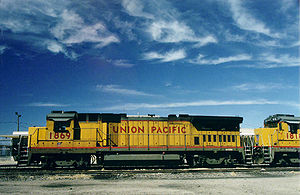 >- align = "center"
>- align = "center" |
Dash 8-40BW GE Dash 8-40BW The Dash 8-40BW, or B40-8W as some call it, is a four-axle road diesel locomotive built by GE Transportation Systems for the Atchison, Topeka and Santa Fe Railway in the early 1990s... (B40-8W) |
1990 | 83 | B-B | GE 7FDL-16 | 4,000 hp Horsepower Horsepower is the name of several units of measurement of power. The most common definitions equal between 735.5 and 750 watts.Horsepower was originally defined to compare the output of steam engines with the power of draft horses in continuous operation. The unit was widely adopted to measure the... (2.9 MW) |
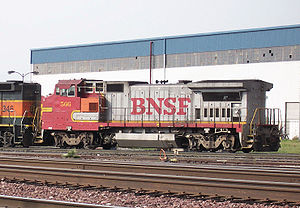 |
|---|
Six axles
| Model designation | Build year | Total produced | AAR wheel arrangement AAR wheel arrangement The AAR wheel arrangement system is a method of classifying locomotive wheel arrangements that was developed by the Association of American Railroads. It is essentially a simplification of the European UIC classification, and it is widely used in North America to describe diesel and electric... | Prime mover Prime mover (locomotive) In engineering, a prime mover is an engine that converts fuel to useful work. In locomotives, the prime mover is thus the source of power for its propulsion. The term is generally used when discussing any locomotive powered by an internal combustion engine... | |Power output Horsepower Horsepower is the name of several units of measurement of power. The most common definitions equal between 735.5 and 750 watts.Horsepower was originally defined to compare the output of steam engines with the power of draft horses in continuous operation. The unit was widely adopted to measure the... | Dash 8-32C GE C32-8 The GE C32-8 was a 6-axle diesel locomotive built by GE Transportation Systems in 1984. Only 10 of these 3,200 hp locomotives were built. These were some of the first locomotives built in the DASH-8 line with all 10 going to Conrail as road numbers 6610 to 6619. When delivered they wore the... (C32-8) |
1984 | 10 | C-C | GE 7FDL-12 | 3,200 hp Horsepower Horsepower is the name of several units of measurement of power. The most common definitions equal between 735.5 and 750 watts.Horsepower was originally defined to compare the output of steam engines with the power of draft horses in continuous operation. The unit was widely adopted to measure the... (2.3 MW) |
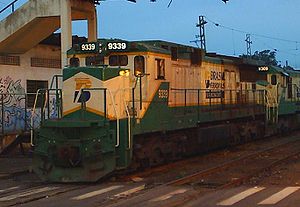 >- align = "center"
>- align = "center" |
Dash 8-36C (C36-8) | 1983 | 1 | C-C | GE 7FDL-16 | 3600 hp | >- align = "center" | Dash 8-39C GE C39-8 The GE C39-8 is a 6-axle diesel locomotive built by GE Transportation Systems between 1984 and 1987. 161 examples of this locomotive were built for two North American railroads: Conrail and Norfolk Southern Railway.- Technical :... (C39-8) |
1983-87 | 162 | C-C | GE 7FDL-16 | 3900 hp | >- align = "center" | Dash 8-40C GE Dash 8-40C A GE Dash 8-40C is a 6-axle diesel locomotive built by GE Transportation Systems between 1987 and 1992, wheel arrangement is of a C-C type. This locomotive model is sometimes referred to as a C40-8. or simply "Dash 8". "Dash 8" in general refers to the electrical control series, "Dash" being a... (C40-8) |
1983-87 | 585 | C-C | GE 7FDL-16 | 4,000 hp Horsepower Horsepower is the name of several units of measurement of power. The most common definitions equal between 735.5 and 750 watts.Horsepower was originally defined to compare the output of steam engines with the power of draft horses in continuous operation. The unit was widely adopted to measure the... (2.9 MW) |
Dash 8-40CM GE Dash 8-40CM The GE Dash 8-40CM is a 6-axle diesel locomotive built by GE Transportation Systems from 1990 to 1994. It is distinguished from the Dash 8-40CW by the addition of a full-width cowl body and the use of a Canada-specific nose and windshield configuration... (C40-8M) |
1990 | 84 | C-C | GE 7FDL-16 | 4,000 hp Horsepower Horsepower is the name of several units of measurement of power. The most common definitions equal between 735.5 and 750 watts.Horsepower was originally defined to compare the output of steam engines with the power of draft horses in continuous operation. The unit was widely adopted to measure the... (2.9 MW) |
>- align = "center" | Dash 8-40CW GE Dash 8-40CW A GE Dash 8-40CW is a 6-axle diesel locomotive built by GE Transportation Systems from 1990 to 1994. It is distinguished from the Dash 8-40C by the addition of a "wide" or "safety" cab. This locomotive model is sometimes referred to as a C40-8W... (C40-8W) |
1990-94 | 875 | C-C | GE 7FDL-16 | 4,000 hp Horsepower Horsepower is the name of several units of measurement of power. The most common definitions equal between 735.5 and 750 watts.Horsepower was originally defined to compare the output of steam engines with the power of draft horses in continuous operation. The unit was widely adopted to measure the... (2.9 MW) |
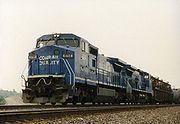 >- align = "center"
>- align = "center" |
Dash 8-41CW GE Dash 8-40CW A GE Dash 8-40CW is a 6-axle diesel locomotive built by GE Transportation Systems from 1990 to 1994. It is distinguished from the Dash 8-40C by the addition of a "wide" or "safety" cab. This locomotive model is sometimes referred to as a C40-8W... (C41-8W) |
1993 | 27 | C-C | GE 7FDL-16 | 4100 hp | Dash 8-44CW GE Dash 8-44CW The GE C44-8W is a 4,400 hp diesel locomotive built by GE Transportation Systems of Erie, Pennsylvania. Keeping in tradition with GE's locomotive series nicknames beginning with the "Dash 8" of the 1970s, the C44-8W was dubbed the "Dash 8" upon its debut in 1990. The design has since proven... (C44-8W) |
1993 | 53 | C-C | GE 7FDL-16 | 4400 hp |
|---|
Eight axles
| Model designation | Build year | Total produced | AAR wheel arrangement AAR wheel arrangement The AAR wheel arrangement system is a method of classifying locomotive wheel arrangements that was developed by the Association of American Railroads. It is essentially a simplification of the European UIC classification, and it is widely used in North America to describe diesel and electric... | Prime mover Prime mover (locomotive) In engineering, a prime mover is an engine that converts fuel to useful work. In locomotives, the prime mover is thus the source of power for its propulsion. The term is generally used when discussing any locomotive powered by an internal combustion engine... | |Power output Horsepower Horsepower is the name of several units of measurement of power. The most common definitions equal between 735.5 and 750 watts.Horsepower was originally defined to compare the output of steam engines with the power of draft horses in continuous operation. The unit was widely adopted to measure the... | Dash-8 BB40-8M | 6 | B-B+B-B | GE 7FDL-16 | 4100 hp |
|---|
Dash 9 Series (introduced 1993)
The Dash 9 series introduced primarily electronics updates to the Dash 8 line. Also introduced was the HiAd (High-Adhesion) truck. Split-cooling was standard.Six axles
| Model designation | Build year | Total produced | AAR wheel arrangement AAR wheel arrangement The AAR wheel arrangement system is a method of classifying locomotive wheel arrangements that was developed by the Association of American Railroads. It is essentially a simplification of the European UIC classification, and it is widely used in North America to describe diesel and electric... | Prime mover Prime mover (locomotive) In engineering, a prime mover is an engine that converts fuel to useful work. In locomotives, the prime mover is thus the source of power for its propulsion. The term is generally used when discussing any locomotive powered by an internal combustion engine... | |Power output Horsepower Horsepower is the name of several units of measurement of power. The most common definitions equal between 735.5 and 750 watts.Horsepower was originally defined to compare the output of steam engines with the power of draft horses in continuous operation. The unit was widely adopted to measure the... | Dash 9-40C GE Dash 9-40C The GE Dash 9-40C is a 4,000 hp diesel locomotive that was built by GE Transportation Systems of Erie, Pennsylvania between January 1995 and March 1995. The C40-9 was built with a lower horsepower rating than standard, 4,000 hp instead of the then GE standard 4,400 hp. These... |
1995 | 125 | C-C | GE 7FDL-16 | 4,000 hp Horsepower Horsepower is the name of several units of measurement of power. The most common definitions equal between 735.5 and 750 watts.Horsepower was originally defined to compare the output of steam engines with the power of draft horses in continuous operation. The unit was widely adopted to measure the... (2.9 MW) |
Dash 9-40CW GE Dash 9-40CW The GE Dash 9-40CW is a diesel locomotive that was built by GE Transportation Systems of Erie, Pennsylvania between January 1996 and September 2004. All 1,090 units were built for Norfolk Southern Railway, as road numbers 8889 to 9978. Part of the "Dash 9" locomotive series, these units are... |
1996–2004 | 1,090 | C-C | GE 7FDL-16 | 4,000 hp Horsepower Horsepower is the name of several units of measurement of power. The most common definitions equal between 735.5 and 750 watts.Horsepower was originally defined to compare the output of steam engines with the power of draft horses in continuous operation. The unit was widely adopted to measure the... (2.9 MW) |
Dash 9-44CW GE Dash 9-44CW The GE C44-9W is a 4,400 hp diesel locomotive built by GE Transportation Systems of Erie, Pennsylvania. Keeping in tradition with GE's locomotive series nicknames beginning with the "Dash 7" of the 1970s, the C44-9W was dubbed the Dash 9 upon its debut in 1993. The design has since proven popular... |
1993-2004 | 2,494 | C-C | GE 7FDL-16 | 4,400 hp Horsepower Horsepower is the name of several units of measurement of power. The most common definitions equal between 735.5 and 750 watts.Horsepower was originally defined to compare the output of steam engines with the power of draft horses in continuous operation. The unit was widely adopted to measure the... (3.2 MW) |
>- align = "center" | C38EMi GE Dash 9-44CW The GE C44-9W is a 4,400 hp diesel locomotive built by GE Transportation Systems of Erie, Pennsylvania. Keeping in tradition with GE's locomotive series nicknames beginning with the "Dash 7" of the 1970s, the C44-9W was dubbed the Dash 9 upon its debut in 1993. The design has since proven popular... |
2006 | 55 | C-C | GE 7FDL-16 | 3800 hp | >- align = "center" | C38AChe China Railways NJ2 NJ2 is a class of diesel-electric locomotives employed by China Railways. Built in Erie, Pennsylvania, it is a standard GE Transportation Systems GE Dash 9-44CW and marketed as GE C38AChe. It was specially-designed for high altitude operation on the Qinghai-Tibet Railway route... |
2005-2006 | 78 | C-C | GE 7FDL-16 | 3800 hp | 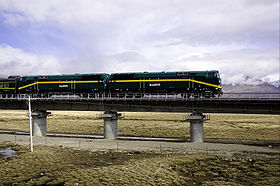 |
|---|
Eight axles
| Model designation | Build year | Total produced | AAR wheel arrangement AAR wheel arrangement The AAR wheel arrangement system is a method of classifying locomotive wheel arrangements that was developed by the Association of American Railroads. It is essentially a simplification of the European UIC classification, and it is widely used in North America to describe diesel and electric... | Prime mover Prime mover (locomotive) In engineering, a prime mover is an engine that converts fuel to useful work. In locomotives, the prime mover is thus the source of power for its propulsion. The term is generally used when discussing any locomotive powered by an internal combustion engine... | |Power output Horsepower Horsepower is the name of several units of measurement of power. The most common definitions equal between 735.5 and 750 watts.Horsepower was originally defined to compare the output of steam engines with the power of draft horses in continuous operation. The unit was widely adopted to measure the... | Dash-9 BB40-9W GE BB40-9W The GE BB40-9W is a narrow-gauge version of the popular GE C40-9W locomotive. All 141 examples of this locomotive are owned by the EFVM railroad in Brazil. They are equipped with four B-style trucks, two at each end replacing the conventional C-style trucks. This is necessary because EFVM tracks... |
1997–2006 | 141 (for Vitoria a Minas, Brazil) | B-B+B-B | GE 7FDL-16 | 4,000 hp Horsepower Horsepower is the name of several units of measurement of power. The most common definitions equal between 735.5 and 750 watts.Horsepower was originally defined to compare the output of steam engines with the power of draft horses in continuous operation. The unit was widely adopted to measure the... (2,980 kW) |
 |
|---|
AC Series (introduced 1994)
These feature the same carbody design and many of the internal components as the Dash-9 series, except they are equipped with AC tractionAlternating current
In alternating current the movement of electric charge periodically reverses direction. In direct current , the flow of electric charge is only in one direction....
motors instead of the conventional DC versions. The cab air conditioner was moved from the left (conductor's) side walkway to a position under the cab floor to make space for the six traction inverters (one per axle) that supply the AC current to the traction motors.
Six axles
| Model designation | Build year | Total produced | AAR wheel arrangement AAR wheel arrangement The AAR wheel arrangement system is a method of classifying locomotive wheel arrangements that was developed by the Association of American Railroads. It is essentially a simplification of the European UIC classification, and it is widely used in North America to describe diesel and electric... | Prime mover Prime mover (locomotive) In engineering, a prime mover is an engine that converts fuel to useful work. In locomotives, the prime mover is thus the source of power for its propulsion. The term is generally used when discussing any locomotive powered by an internal combustion engine... | |Power output Horsepower Horsepower is the name of several units of measurement of power. The most common definitions equal between 735.5 and 750 watts.Horsepower was originally defined to compare the output of steam engines with the power of draft horses in continuous operation. The unit was widely adopted to measure the... | AC4400CW GE AC4400CW The GE AC4400CW is a diesel-electric locomotive that was built by GE Transportation Systems between 1993 and 2004. It is similar to the Dash 9-44CW, but features AC traction motors instead of DC, with a separate inverter per motor. 2,598 examples of this locomotive were produced for North American... |
1993–2004 | 2,598 | C-C | GE 7FDL-16 | 4,400 hp Horsepower Horsepower is the name of several units of measurement of power. The most common definitions equal between 735.5 and 750 watts.Horsepower was originally defined to compare the output of steam engines with the power of draft horses in continuous operation. The unit was widely adopted to measure the... (3.2 MW) |
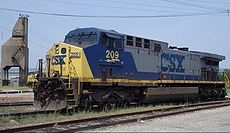 >- align = "center"
>- align = "center" |
*AC6000CW GE AC6000CW The AC6000CW is a diesel electric locomotive that is built by GE Transportation Systems. They are all used by major railroads in the United States, except for 8 units exported to BHP Billiton Iron Ore in Australia... |
303 | C-C | GE 7HDL-16 | 6,250 hp Horsepower Horsepower is the name of several units of measurement of power. The most common definitions equal between 735.5 and 750 watts.Horsepower was originally defined to compare the output of steam engines with the power of draft horses in continuous operation. The unit was widely adopted to measure the... (4.6 MW) |
 >- align = "center"
>- align = "center"| AC44i |
C-C |
|---|
- *Note: two versions: one contained a 16-cylinder 7HDL, co-developed by GE and the German firm Deutz-MWMDeutz AGDeutz AG is an engine manufacturer, based in Cologne, Germany.-History:The company was founded by Nikolaus Otto, inventor of the four-stroke internal combustion engine, in 1864 as N. A...
, rated at 6000 HP; the other a 16-cylinder 7FDL rated at 4390 HP. The units equipped with the 7FDL were a sub-version AC6000 "Convertible" and were produced to get the type into operation while the 7HDL was developed. Much like the SD90/43MACsEMD SD90MACThe EMD SD90MAC is a C-C diesel-electric hood unit locomotive produced by General Motors Electro-Motive Division. It is, with the SD80MAC, one of the largest single-engined locomotives produced by that company, surpassed only by the dual-engined DD series...
produced by competitor EMD, the intention was to someday upgrade the units with larger engines, but the upgrades rarely, if ever, happened.
Evolution Series (introduced 2005)
The Evolution SeriesGE Evolution Series
The Evolution Series is a line of diesel locomotives built by GE Transportation Systems, designed to meet the U.S. EPA's Tier 2 locomotive emissions standards that took effect in 2005. The first pre-production units were built in 2003. Evolution Series locomotives are equipped with either AC or DC...
locomotives replace the Dash 9 and AC series in North America and exceed the new U.S. EPA
United States Environmental Protection Agency
The U.S. Environmental Protection Agency is an agency of the federal government of the United States charged with protecting human health and the environment, by writing and enforcing regulations based on laws passed by Congress...
Tier II emissions standards that took effect in 2005, reducing nitrogen oxides emissions by over 40% and improving fuel consumption as well. They use the new GEVO engine (based in part on the 7HDL design) which produces the same power from twelve cylinders as previous locomotives' 16-cylinder 7FDL engine. Both AC and DC Evolution Series share the same carbody design. The radiator "wings" are even larger than those of the Dash 9 and AC series. Like those on the AC6000CW, they extend past the end of the long hood. Unlike any previous GE locomotive type underside of the wings are divided into two sections with different angles.
Six axles
| Model designation | |Build year | Total produced | AAR wheel arrangement AAR wheel arrangement The AAR wheel arrangement system is a method of classifying locomotive wheel arrangements that was developed by the Association of American Railroads. It is essentially a simplification of the European UIC classification, and it is widely used in North America to describe diesel and electric... | Prime mover Prime mover (locomotive) In engineering, a prime mover is an engine that converts fuel to useful work. In locomotives, the prime mover is thus the source of power for its propulsion. The term is generally used when discussing any locomotive powered by an internal combustion engine... | |Power output Horsepower Horsepower is the name of several units of measurement of power. The most common definitions equal between 735.5 and 750 watts.Horsepower was originally defined to compare the output of steam engines with the power of draft horses in continuous operation. The unit was widely adopted to measure the... | ES40DC | 2005- | 522 | C-C | GEVO-12 | 4,000 hp Horsepower Horsepower is the name of several units of measurement of power. The most common definitions equal between 735.5 and 750 watts.Horsepower was originally defined to compare the output of steam engines with the power of draft horses in continuous operation. The unit was widely adopted to measure the... (2.9 MW) |
 >- align = "center"
>- align = "center" |
ES44DC | 2005- | 811 | C-C | GEVO-12 | 4,400 hp Horsepower Horsepower is the name of several units of measurement of power. The most common definitions equal between 735.5 and 750 watts.Horsepower was originally defined to compare the output of steam engines with the power of draft horses in continuous operation. The unit was widely adopted to measure the... (3.2 MW) |
>- align = "center" | ES44AC | 2005- | 2,374 | C-C | GEVO-12 | 4,400 hp Horsepower Horsepower is the name of several units of measurement of power. The most common definitions equal between 735.5 and 750 watts.Horsepower was originally defined to compare the output of steam engines with the power of draft horses in continuous operation. The unit was widely adopted to measure the... (3.2 MW) |
>- align = "center" | ES44C4 | 2009- | 48 | A1A-A1A | GEVO-12 | 4,400 hp Horsepower Horsepower is the name of several units of measurement of power. The most common definitions equal between 735.5 and 750 watts.Horsepower was originally defined to compare the output of steam engines with the power of draft horses in continuous operation. The unit was widely adopted to measure the... (3.2 MW) |
|---|
Six axles
| Model designation | |Build year | Total produced | AAR wheel arrangement AAR wheel arrangement The AAR wheel arrangement system is a method of classifying locomotive wheel arrangements that was developed by the Association of American Railroads. It is essentially a simplification of the European UIC classification, and it is widely used in North America to describe diesel and electric... | Prime mover Prime mover (locomotive) In engineering, a prime mover is an engine that converts fuel to useful work. In locomotives, the prime mover is thus the source of power for its propulsion. The term is generally used when discussing any locomotive powered by an internal combustion engine... | |Power output Horsepower Horsepower is the name of several units of measurement of power. The most common definitions equal between 735.5 and 750 watts.Horsepower was originally defined to compare the output of steam engines with the power of draft horses in continuous operation. The unit was widely adopted to measure the... | PH37ACmi | 2009- | C-C | GE PowerHaul P616 | 3,690 hp Horsepower Horsepower is the name of several units of measurement of power. The most common definitions equal between 735.5 and 750 watts.Horsepower was originally defined to compare the output of steam engines with the power of draft horses in continuous operation. The unit was widely adopted to measure the... (2.7 MW) |
|---|
Passenger locomotives
While primarily a builder of freight locomotives, GE has on occasion been called upon to construct passenger models for specific customers. The most recent is the P42DC, ordered by AmtrakAmtrak
The National Railroad Passenger Corporation, doing business as Amtrak , is a government-owned corporation that was organized on May 1, 1971, to provide intercity passenger train service in the United States. "Amtrak" is a portmanteau of the words "America" and "track". It is headquartered at Union...
to replace the aging EMD F40PH
EMD F40PH
-Amtrak NPCU Conversions:In later years, as Amtrak's F40PH fleet was being replaced by the newer GE Genesis-series locomotives, Amtrak converted a number of the retired units—generally ones with major mechanical problems limiting their value in the resale or lease marketplace—into "Non-Power...
. Additional units have been built for Via Rail Canada.
| Model designation | Build year | Total produced | AAR wheel arrangement AAR wheel arrangement The AAR wheel arrangement system is a method of classifying locomotive wheel arrangements that was developed by the Association of American Railroads. It is essentially a simplification of the European UIC classification, and it is widely used in North America to describe diesel and electric... | Prime mover Prime mover (locomotive) In engineering, a prime mover is an engine that converts fuel to useful work. In locomotives, the prime mover is thus the source of power for its propulsion. The term is generally used when discussing any locomotive powered by an internal combustion engine... | |Power output Horsepower Horsepower is the name of several units of measurement of power. The most common definitions equal between 735.5 and 750 watts.Horsepower was originally defined to compare the output of steam engines with the power of draft horses in continuous operation. The unit was widely adopted to measure the... | U28CG GE U28CG The GE U28CG was a passenger-hauling diesel-electric locomotive produced in 1966 by GE Transportation Systems and derived from their freight-hauling U28C design... |
1966 | 10 | C-C | GE FDL-16 | 2,800 hp Horsepower Horsepower is the name of several units of measurement of power. The most common definitions equal between 735.5 and 750 watts.Horsepower was originally defined to compare the output of steam engines with the power of draft horses in continuous operation. The unit was widely adopted to measure the... (2.0 MW) |
>- align = "center" | U30CG GE U30CG The GE U30CG was a passenger-hauling diesel-electric locomotive built by GE Transportation Systems. It was a passenger variant of GE's U30C design purchased by the Atchison, Topeka and Santa Fe Railway. ATSF had purchased ten U28CG locomotives in 1966, but while these locomotives were... |
1967 | 6 | C-C | GE FDL-16 | 3000 hp | >- align = "center" | U34CH GE U34CH The U34CH is a 3600hp passenger diesel locomotive built by General Electric between 1970-73. In total, 33 U34CH units were built; 32 were built for the New Jersey Department of Transportation and operated by the Erie Lackawanna Railway, with the last unit coming as a later rebuild of a GE U30C for... |
1970 | 33 | C-C | GE FDL-16 | 3,600 hp Horsepower Horsepower is the name of several units of measurement of power. The most common definitions equal between 735.5 and 750 watts.Horsepower was originally defined to compare the output of steam engines with the power of draft horses in continuous operation. The unit was widely adopted to measure the... (2.7 MW) |
>- align = "center" | U36CG | 1974 | 20 | C-C | GE FDL-16 | 3600 hp | >- align = "center" | P30CH GE P30CH The GE P30CH was one of the first brand-new Diesel-electric locomotives built for Amtrak in the company's early years. The design was based on the GE U30C, but had a cowl carbody like its EMD competitors.25 P30CHs were ordered by Amtrak in 1974, just after Amtrak ordered 40 EMD SDP40Fs in 1973... |
1974 | 25 | C-C | GE FDL-16 | 3000 hp | >- align = "center" | P32-8WH GE Dash 8-32BWH The GE Dash 8-32BWH, also known as the P32-8WH or B32-8WH, is a modern diesel-electric passenger train locomotive used by Amtrak. It is based on GE's Dash 8 series of freight train locomotives.... |
1990 | 20 | B-B | GE 7FDL-12 | 3200 hp | 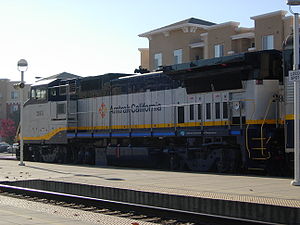 >- align = "center"
>- align = "center" |
P40DC | 1992–2001 | 44 | B-B | GE 7FDL-16 | 4000 hp | P32AC-DM | 50 | B-B | GE 7FDL-12 | 3200 hp | >- align = "center" | P42DC | 1991-2005 | 228 | B-B | GE 7FDL-16 | 4,250 hp Horsepower Horsepower is the name of several units of measurement of power. The most common definitions equal between 735.5 and 750 watts.Horsepower was originally defined to compare the output of steam engines with the power of draft horses in continuous operation. The unit was widely adopted to measure the... (3.2 MW) |
|---|
Electric locomotives
| Model designation | Build year | Total produced | AAR wheel arrangement AAR wheel arrangement The AAR wheel arrangement system is a method of classifying locomotive wheel arrangements that was developed by the Association of American Railroads. It is essentially a simplification of the European UIC classification, and it is widely used in North America to describe diesel and electric... | Supply Voltage Voltage Voltage, otherwise known as electrical potential difference or electric tension is the difference in electric potential between two points — or the difference in electric potential energy per unit charge between two points... | |Power output Horsepower Horsepower is the name of several units of measurement of power. The most common definitions equal between 735.5 and 750 watts.Horsepower was originally defined to compare the output of steam engines with the power of draft horses in continuous operation. The unit was widely adopted to measure the... | NYC T-1 later reclassed as S-1 |
1904 | 1 New York Central Railroad New York Central Railroad The New York Central Railroad , known simply as the New York Central in its publicity, was a railroad operating in the Northeastern United States... |
1-D-1 rebuilt to 2-D-2 |
600 V DC | 1695 hp | 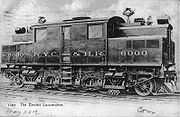 |
|---|---|---|---|---|---|---|
| NYC T-2 later reclassed as S-2 |
1906 | 34 New York Central Railroad New York Central Railroad The New York Central Railroad , known simply as the New York Central in its publicity, was a railroad operating in the Northeastern United States... |
1-D-1 rebuilt to 2-D-2 |
600 V DC | 1695 hp | |
| NYC S-3 | 1908–1909 | 12 New York Central Railroad New York Central Railroad The New York Central Railroad , known simply as the New York Central in its publicity, was a railroad operating in the Northeastern United States... |
2-D-2 | 600 V DC | 1695 hp | |
| GN boxcab | 1909 | 4 Great Northern Railway | B+B | 6,000 V Volt The volt is the SI derived unit for electric potential, electric potential difference, and electromotive force. The volt is named in honor of the Italian physicist Alessandro Volta , who invented the voltaic pile, possibly the first chemical battery.- Definition :A single volt is defined as the... , 3 phase AC Alternating current In alternating current the movement of electric charge periodically reverses direction. In direct current , the flow of electric charge is only in one direction.... |
1000 hp | |
| NH 068 | 1912 | 1 New York, New Haven and Hartford Railroad New York, New Haven and Hartford Railroad The New York, New Haven and Hartford Railroad , was a railroad that operated in the northeast United States from 1872 to 1968 which served the states of Connecticut, New York, Rhode Island, and Massachusetts... |
2-B+B-2 | 11,000 V Volt The volt is the SI derived unit for electric potential, electric potential difference, and electromotive force. The volt is named in honor of the Italian physicist Alessandro Volta , who invented the voltaic pile, possibly the first chemical battery.- Definition :A single volt is defined as the... AC Alternating current In alternating current the movement of electric charge periodically reverses direction. In direct current , the flow of electric charge is only in one direction.... , 25 Hz Hertz The hertz is the SI unit of frequency defined as the number of cycles per second of a periodic phenomenon. One of its most common uses is the description of the sine wave, particularly those used in radio and audio applications.... |
1560 hp | |
| NYC T-1b T-Motor T-Motor was the name given by the New York Central to its ALCO-GE T1a, T1b, T2a, T2b, and T3a electric locomotives. After the New York Central was merged into Penn Central, Penn Central continued operating them.-History:... |
1913 | 10 New York Central Railroad New York Central Railroad The New York Central Railroad , known simply as the New York Central in its publicity, was a railroad operating in the Northeastern United States... |
B+B-B+B | 600 V DC | 2500 hp | |
| NYC T-2a T-Motor T-Motor was the name given by the New York Central to its ALCO-GE T1a, T1b, T2a, T2b, and T3a electric locomotives. After the New York Central was merged into Penn Central, Penn Central continued operating them.-History:... |
1914 | 16 New York Central Railroad New York Central Railroad The New York Central Railroad , known simply as the New York Central in its publicity, was a railroad operating in the Northeastern United States... |
B+B-B+B | 600 V DC | 2500 hp | |
| CN Boxcab Electric | 1914-16 | 6 Canadian Northern Railway Canadian Northern Railway The Canadian Northern Railway is a historic Canadian transcontinental railway. At its demise in 1923, when it was merged into the Canadian National Railway , the CNoR owned a main line between Quebec City and Vancouver via Ottawa, Winnipeg, and Edmonton.-Manitoba beginnings:CNoR had its start in... (later Canadian National Railway Canadian National Railway The Canadian National Railway Company is a Canadian Class I railway headquartered in Montreal, Quebec. CN's slogan is "North America's Railroad".... ) |
B+B | 2400 V DC | 1100 hp | 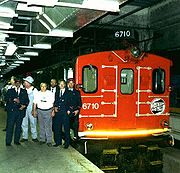 |
| MILW EF-1 / EP-1 Milwaukee Road class EP-1, EF-1, EF-2, EF-3, and EF-5 The Chicago, Milwaukee, St. Paul and Pacific Railroad classes EP-1 and EF-1 comprised 42 boxcab electric locomotives built by the American Locomotive Company in 1915. Electrical components were from General Electric. The locomotives were composed of two half-units semi-permanently coupled... |
1915–1917 | 42 Milwaukee Road | 2-B+B+B+B-2 | 3000 V DC | 3340 hp |  |
| MILW ES-1 Milwaukee Road class ES-1 The Milwaukee Road's class ES-1 comprised a single electric switcher locomotive built in 1915. It was designed to run on the unique 1,500 V DC electrification in the yard at Great Falls, Montana. It was originally numbered #10000 and was numbered E85 in March 1939. It was retired in November... |
1915 | 1 Milwaukee Road | B-B | 1500 V DC | 316 hp | |
| MILW ES-2 Milwaukee Road class ES-2 The Milwaukee Road's class ES-2 comprised four electric switcher locomotives . Two were built in 1916 and the final two in 1919. They were of steeplecab design, with a single roof-mounted pantograph to access the Milwaukee's 3,000 V DC overhead line. Originally numbered 10050–10053, they... |
1916, 1919 | 4 Milwaukee Road | B-B | 3000 V DC | 475 hp |  |
| MILW EP-2 Milwaukee Road class EP-2 The Milwaukee Road's class EP-2 comprised five electric locomotives built by General Electric in 1919. They were often known as Bipolars, which referred to the bipolar electric motors they used. Among the most distinctive and powerful electric locomotives of their time, they epitomized the... (“Bi-polar”) |
1919 | 5 Milwaukee Road | 1B+D+D+B1 | 3000 V DC | 3180 hp |  |
| Mexican Railway Boxcabs |
1923 | 10 Mexican Railway Mexican Railway The Mexican Railway was one of the primary pre-nationalization railways of Mexico. Incorporated in London in September 1864 as the Imperial Mexican Railway to complete an earlier project, it was renamed in July 1867 after the Second French Empire withdrew from Mexico... |
B+B+B | 3000 V DC | 2520 hp | |
| NYC R | 1926 | 2 New York Central Railroad New York Central Railroad The New York Central Railroad , known simply as the New York Central in its publicity, was a railroad operating in the Northeastern United States... |
B-B+B-B | 600 V DC | 3320 hp | |
| NYC Q | 1926 | New York Central Railroad New York Central Railroad The New York Central Railroad , known simply as the New York Central in its publicity, was a railroad operating in the Northeastern United States... |
B-B | 600 V DC | 1665 hp | |
| NYC T-3 T-Motor T-Motor was the name given by the New York Central to its ALCO-GE T1a, T1b, T2a, T2b, and T3a electric locomotives. After the New York Central was merged into Penn Central, Penn Central continued operating them.-History:... |
1926 | 10 New York Central Railroad New York Central Railroad The New York Central Railroad , known simply as the New York Central in its publicity, was a railroad operating in the Northeastern United States... |
B+B-B+B | 600 V DC | 2500 hp | |
| NH EF2 | 1926 | 5 New York, New Haven and Hartford Railroad New York, New Haven and Hartford Railroad The New York, New Haven and Hartford Railroad , was a railroad that operated in the northeast United States from 1872 to 1968 which served the states of Connecticut, New York, Rhode Island, and Massachusetts... |
1-B+B-1 | 1350 hp | ||
| NH EY3 | 1926 | 2 New York, New Haven and Hartford Railroad New York, New Haven and Hartford Railroad The New York, New Haven and Hartford Railroad , was a railroad that operated in the northeast United States from 1872 to 1968 which served the states of Connecticut, New York, Rhode Island, and Massachusetts... |
B+B | 11,000 V Volt The volt is the SI derived unit for electric potential, electric potential difference, and electromotive force. The volt is named in honor of the Italian physicist Alessandro Volta , who invented the voltaic pile, possibly the first chemical battery.- Definition :A single volt is defined as the... AC Alternating current In alternating current the movement of electric charge periodically reverses direction. In direct current , the flow of electric charge is only in one direction.... , 25 Hz Hertz The hertz is the SI unit of frequency defined as the number of cycles per second of a periodic phenomenon. One of its most common uses is the description of the sine wave, particularly those used in radio and audio applications.... |
500 hp | |
| GN Y-1 (PRR FF2 PRR FF2 The Pennsylvania Railroad's class FF2 was a group of American electric locomotives which comprised eight boxcab units, purchased from the Great Northern Railway in 1956 following the GN's dismantling of its Cascade Tunnel electrification. They had been built by the American Locomotive Company and... ) |
1927–1930 | 8 Great Northern Railway (sold to Pennsylvania Railroad) |
1-C+C-1 | 11,000 V Volt The volt is the SI derived unit for electric potential, electric potential difference, and electromotive force. The volt is named in honor of the Italian physicist Alessandro Volta , who invented the voltaic pile, possibly the first chemical battery.- Definition :A single volt is defined as the... AC Alternating current In alternating current the movement of electric charge periodically reverses direction. In direct current , the flow of electric charge is only in one direction.... , 25 Hz Hertz The hertz is the SI unit of frequency defined as the number of cycles per second of a periodic phenomenon. One of its most common uses is the description of the sine wave, particularly those used in radio and audio applications.... |
3000 hp | |
| CUT P1-a | 1929–1930 | 22 Cleveland Union Terminal to New York Central Railroad New York Central Railroad The New York Central Railroad , known simply as the New York Central in its publicity, was a railroad operating in the Northeastern United States... and rebuilt to class P-2 |
2-C+C-2 | 3000 V DC rebuilt 600 V DC |
4243 hp | |
| NYC R-2 | 1930–1931 | 42 New York Central Railroad New York Central Railroad The New York Central Railroad , known simply as the New York Central in its publicity, was a railroad operating in the Northeastern United States... |
C-C | 600 V DC | 2500 hp | |
| NH EP3 | 1931 | 10 New York, New Haven and Hartford Railroad New York, New Haven and Hartford Railroad The New York, New Haven and Hartford Railroad , was a railroad that operated in the northeast United States from 1872 to 1968 which served the states of Connecticut, New York, Rhode Island, and Massachusetts... |
2-C+C-2 | 11,000 V Volt The volt is the SI derived unit for electric potential, electric potential difference, and electromotive force. The volt is named in honor of the Italian physicist Alessandro Volta , who invented the voltaic pile, possibly the first chemical battery.- Definition :A single volt is defined as the... AC Alternating current In alternating current the movement of electric charge periodically reverses direction. In direct current , the flow of electric charge is only in one direction.... , 25 Hz Hertz The hertz is the SI unit of frequency defined as the number of cycles per second of a periodic phenomenon. One of its most common uses is the description of the sine wave, particularly those used in radio and audio applications.... / 600 V DC |
3440 hp | |
| PRR P5 PRR P5 The Pennsylvania Railroad's class P5 comprised 92 mixed-traffic electric locomotives constructed 1931–1935 by the PRR, Westinghouse and General Electric.... a |
1932 | 25 Pennsylvania Railroad Pennsylvania Railroad The Pennsylvania Railroad was an American Class I railroad, founded in 1846. Commonly referred to as the "Pennsy", the PRR was headquartered in Philadelphia, Pennsylvania.... (+13 by PRR, +54 by Westinghouse) |
2-C-2 | 11,000 V Volt The volt is the SI derived unit for electric potential, electric potential difference, and electromotive force. The volt is named in honor of the Italian physicist Alessandro Volta , who invented the voltaic pile, possibly the first chemical battery.- Definition :A single volt is defined as the... AC Alternating current In alternating current the movement of electric charge periodically reverses direction. In direct current , the flow of electric charge is only in one direction.... , 25 Hz Hertz The hertz is the SI unit of frequency defined as the number of cycles per second of a periodic phenomenon. One of its most common uses is the description of the sine wave, particularly those used in radio and audio applications.... |
3750 hp | |
| PRR GG1 PRR GG1 The PRR GG1 is a class of electric locomotives that was built for the Pennsylvania Railroad for use in the northeastern United States. A total of 140 GG1s were constructed by its designer General Electric and the Pennsylvania's Altoona Works from 1934 to 1943.... |
1934–1935 (PRR: 1935–43) |
15 Pennsylvania Railroad Pennsylvania Railroad The Pennsylvania Railroad was an American Class I railroad, founded in 1846. Commonly referred to as the "Pennsy", the PRR was headquartered in Philadelphia, Pennsylvania.... (+124 by PRR) |
2-C+C-2 | 11,000 V Volt The volt is the SI derived unit for electric potential, electric potential difference, and electromotive force. The volt is named in honor of the Italian physicist Alessandro Volta , who invented the voltaic pile, possibly the first chemical battery.- Definition :A single volt is defined as the... AC Alternating current In alternating current the movement of electric charge periodically reverses direction. In direct current , the flow of electric charge is only in one direction.... , 25 Hz Hertz The hertz is the SI unit of frequency defined as the number of cycles per second of a periodic phenomenon. One of its most common uses is the description of the sine wave, particularly those used in radio and audio applications.... |
4620 hp |  |
| NH EP4 | 1938 | 6 New York, New Haven and Hartford Railroad New York, New Haven and Hartford Railroad The New York, New Haven and Hartford Railroad , was a railroad that operated in the northeast United States from 1872 to 1968 which served the states of Connecticut, New York, Rhode Island, and Massachusetts... |
2-C+C-2 | 11,000 V Volt The volt is the SI derived unit for electric potential, electric potential difference, and electromotive force. The volt is named in honor of the Italian physicist Alessandro Volta , who invented the voltaic pile, possibly the first chemical battery.- Definition :A single volt is defined as the... AC Alternating current In alternating current the movement of electric charge periodically reverses direction. In direct current , the flow of electric charge is only in one direction.... , 25 Hz Hertz The hertz is the SI unit of frequency defined as the number of cycles per second of a periodic phenomenon. One of its most common uses is the description of the sine wave, particularly those used in radio and audio applications.... / 600 V DC |
3600 hp | |
| NH EF3a | 1942 | 5 New York, New Haven and Hartford Railroad New York, New Haven and Hartford Railroad The New York, New Haven and Hartford Railroad , was a railroad that operated in the northeast United States from 1872 to 1968 which served the states of Connecticut, New York, Rhode Island, and Massachusetts... |
2-C+C-2 | 11,000 V Volt The volt is the SI derived unit for electric potential, electric potential difference, and electromotive force. The volt is named in honor of the Italian physicist Alessandro Volta , who invented the voltaic pile, possibly the first chemical battery.- Definition :A single volt is defined as the... AC Alternating current In alternating current the movement of electric charge periodically reverses direction. In direct current , the flow of electric charge is only in one direction.... , 25 Hz Hertz The hertz is the SI unit of frequency defined as the number of cycles per second of a periodic phenomenon. One of its most common uses is the description of the sine wave, particularly those used in radio and audio applications.... |
4860 hp | |
| 2-C+C-2 | 1940–48 | 22 Paulista Railway 15 Estrada de Ferro Central do Brasil Estrada de Ferro Central do Brasil The Estrada de Ferro Central do Brasil was one of the principal railways of Brazil, uniting the states of Rio de Janeiro, São Paulo and Minas Gerais.-Origins:... |
2-C+C-2 | 3000 V DC | 3800 hp | |
| 2-D+D-2 Little Joe (electric locomotive) The Little Joe is a type of railroad electric locomotive built by General Electric for export to the Soviet Union in 1946. The locomotives had twelve axles, eight of them powered, in a 2-D+D-2 arrangement... ("Little Joe") |
1946 | 20 Soviet Railways (not delivered – 5 Paulista Railway 3 South Shore Line 12 Milwaukee Road) |
2-D+D-2 | 3,300 V DC As rebuilt by CSS&SB: 1,500 V DC |
5500 hp |  |
| GN W-1 GN W-1 The Great Northern Railway's class W-1 comprised two electric locomotives with AAR B-D+D-B wheel arrangements. The locomotives were used on the electrified portion of the railroad, from Wenatchee, Washington to Skykomish, Washington, including the Cascade Tunnel.The W-1 motor-generator... |
1947 | 2 Great Northern Railway | B-D+D-B | 11,000 V Volt The volt is the SI derived unit for electric potential, electric potential difference, and electromotive force. The volt is named in honor of the Italian physicist Alessandro Volta , who invented the voltaic pile, possibly the first chemical battery.- Definition :A single volt is defined as the... AC Alternating current In alternating current the movement of electric charge periodically reverses direction. In direct current , the flow of electric charge is only in one direction.... , 25 Hz Hertz The hertz is the SI unit of frequency defined as the number of cycles per second of a periodic phenomenon. One of its most common uses is the description of the sine wave, particularly those used in radio and audio applications.... |
5000 hp | |
| VGN EL-2B VGN EL-2B The Virginian Railway's class EL-2B comprised four two-unit electric locomotives with AAR + wheel arrangements. The locomotives were used on the electrified portion of the railroad, from Roanoke, Virginia to Mullens, West Virginia... |
1948 | 4 sets (2 units each) Virginian Railway Virginian Railway The Virginian Railway was a Class I railroad located in Virginia and West Virginia in the United States. The VGN was created to transport high quality "smokeless" bituminous coal from southern West Virginia to port at Hampton Roads.... |
(B+B-B+B)+(B+B-B+B) | 11,000 V AC, 25 Hz | 6800 hp per set |
|
| CN Centercab Electric | 1950 | 3 Canadian National Railway Canadian National Railway The Canadian National Railway Company is a Canadian Class I railway headquartered in Montreal, Quebec. CN's slogan is "North America's Railroad".... |
B-B | 2400 V DC | 1100 hp | |
| PRR E2b PRR E2b Pennsylvania Railroad class E2b comprised six experimental B-B electric locomotives built for the railroad by General Electric.In 1952 the Pennsylvania Railroad took delivery of eight experimental locomotives, four from Westinghouse and four from General Electric. GE also built two demonstrators to... |
1951 | 6 Pennsylvania Railroad Pennsylvania Railroad The Pennsylvania Railroad was an American Class I railroad, founded in 1846. Commonly referred to as the "Pennsy", the PRR was headquartered in Philadelphia, Pennsylvania.... |
B-B | 11,000 V Volt The volt is the SI derived unit for electric potential, electric potential difference, and electromotive force. The volt is named in honor of the Italian physicist Alessandro Volta , who invented the voltaic pile, possibly the first chemical battery.- Definition :A single volt is defined as the... AC Alternating current In alternating current the movement of electric charge periodically reverses direction. In direct current , the flow of electric charge is only in one direction.... , 25 Hz Hertz The hertz is the SI unit of frequency defined as the number of cycles per second of a periodic phenomenon. One of its most common uses is the description of the sine wave, particularly those used in radio and audio applications.... |
2500 hp | |
| NH EP5 (PC E40) New Haven EP5 The New Haven EP-5 was a double-ended mercury arc rectifier electric locomotive built in 1955 by General Electric, for the New York, New Haven and Hartford Railroad... |
1954 | 10 New York, New Haven and Hartford Railroad New York, New Haven and Hartford Railroad The New York, New Haven and Hartford Railroad , was a railroad that operated in the northeast United States from 1872 to 1968 which served the states of Connecticut, New York, Rhode Island, and Massachusetts... |
C-C | 11,000 V Volt The volt is the SI derived unit for electric potential, electric potential difference, and electromotive force. The volt is named in honor of the Italian physicist Alessandro Volta , who invented the voltaic pile, possibly the first chemical battery.- Definition :A single volt is defined as the... AC Alternating current In alternating current the movement of electric charge periodically reverses direction. In direct current , the flow of electric charge is only in one direction.... , 25 Hz Hertz The hertz is the SI unit of frequency defined as the number of cycles per second of a periodic phenomenon. One of its most common uses is the description of the sine wave, particularly those used in radio and audio applications.... / 600 V DC |
4000 hp | |
| VGN EL-C (PC E33) VGN EL-C The Virginian EL-C was a type of electric locomotive built for the Virginian Railway by General Electric in August of 1955. They were the first successful production locomotives to use Ignitron rectifier technology... |
1956–57 | 12 Virginian Railway Virginian Railway The Virginian Railway was a Class I railroad located in Virginia and West Virginia in the United States. The VGN was created to transport high quality "smokeless" bituminous coal from southern West Virginia to port at Hampton Roads.... |
C-C | 11,000 V AC, 25 Hz | 3300 hp | 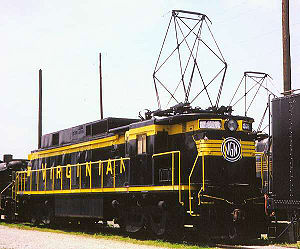 |
| PRR E44 PRR E44 The E44 was an electric, rectifier-equipped locomotive built by GE for the Pennsylvania Railroad between 1960 and 1963. They survived through the PRR and its successors until Conrail abandoned its electric operations in the early 1980s. They were acquired by Amtrak and NJ Transit, where they... |
1960–63 | 44 Pennsylvania Railroad Pennsylvania Railroad The Pennsylvania Railroad was an American Class I railroad, founded in 1846. Commonly referred to as the "Pennsy", the PRR was headquartered in Philadelphia, Pennsylvania.... |
C-C | 11,000 V Volt The volt is the SI derived unit for electric potential, electric potential difference, and electromotive force. The volt is named in honor of the Italian physicist Alessandro Volta , who invented the voltaic pile, possibly the first chemical battery.- Definition :A single volt is defined as the... AC Alternating current In alternating current the movement of electric charge periodically reverses direction. In direct current , the flow of electric charge is only in one direction.... , 25 Hz Hertz The hertz is the SI unit of frequency defined as the number of cycles per second of a periodic phenomenon. One of its most common uses is the description of the sine wave, particularly those used in radio and audio applications.... |
4400 hp | |
| PRR E44 PRR E44 The E44 was an electric, rectifier-equipped locomotive built by GE for the Pennsylvania Railroad between 1960 and 1963. They survived through the PRR and its successors until Conrail abandoned its electric operations in the early 1980s. They were acquired by Amtrak and NJ Transit, where they... a |
1960–63 | 22 Pennsylvania Railroad Pennsylvania Railroad The Pennsylvania Railroad was an American Class I railroad, founded in 1846. Commonly referred to as the "Pennsy", the PRR was headquartered in Philadelphia, Pennsylvania.... |
C-C | 11,000 V Volt The volt is the SI derived unit for electric potential, electric potential difference, and electromotive force. The volt is named in honor of the Italian physicist Alessandro Volta , who invented the voltaic pile, possibly the first chemical battery.- Definition :A single volt is defined as the... AC Alternating current In alternating current the movement of electric charge periodically reverses direction. In direct current , the flow of electric charge is only in one direction.... , 25 Hz Hertz The hertz is the SI unit of frequency defined as the number of cycles per second of a periodic phenomenon. One of its most common uses is the description of the sine wave, particularly those used in radio and audio applications.... |
5000 hp | |
| E50C | 1968 | 2 Muskingum Electric Railroad Muskingum Electric Railroad The Muskingum Electric Railroad was a private coal-carrying railroad owned by American Electric Power, and started operation in 1968. MERR shuttled coal in two trains from the mine to a powerplant at Relief, Ohio , a distance of 20 miles. The trains were driverless and powered by automated General... |
C-C | 25,000 V Volt The volt is the SI derived unit for electric potential, electric potential difference, and electromotive force. The volt is named in honor of the Italian physicist Alessandro Volta , who invented the voltaic pile, possibly the first chemical battery.- Definition :A single volt is defined as the... AC Alternating current In alternating current the movement of electric charge periodically reverses direction. In direct current , the flow of electric charge is only in one direction.... , 60 Hz Hertz The hertz is the SI unit of frequency defined as the number of cycles per second of a periodic phenomenon. One of its most common uses is the description of the sine wave, particularly those used in radio and audio applications.... |
5000 hp | |
| E60C | 1972–76 | 6 Black Mesa and Lake Powell Railroad | C-C | 50,000 V Voltage Voltage, otherwise known as electrical potential difference or electric tension is the difference in electric potential between two points — or the difference in electric potential energy per unit charge between two points... AC Alternating current In alternating current the movement of electric charge periodically reverses direction. In direct current , the flow of electric charge is only in one direction.... , 60 Hz Hertz The hertz is the SI unit of frequency defined as the number of cycles per second of a periodic phenomenon. One of its most common uses is the description of the sine wave, particularly those used in radio and audio applications.... (overhead) |
6000 hp | |
| E60CH / E60CP GE E60 The GE E60 is a C-C electric locomotive made by GE Transportation Systems. The E60's were based on existing locomotives designed for freight service... |
1974–76 | 26 Amtrak Amtrak The National Railroad Passenger Corporation, doing business as Amtrak , is a government-owned corporation that was organized on May 1, 1971, to provide intercity passenger train service in the United States. "Amtrak" is a portmanteau of the words "America" and "track". It is headquartered at Union... |
C-C | 11,000 V AC, 25 Hz 11,000–13,500 V Voltage Voltage, otherwise known as electrical potential difference or electric tension is the difference in electric potential between two points — or the difference in electric potential energy per unit charge between two points... AC Alternating current In alternating current the movement of electric charge periodically reverses direction. In direct current , the flow of electric charge is only in one direction.... 60 Hz Hertz The hertz is the SI unit of frequency defined as the number of cycles per second of a periodic phenomenon. One of its most common uses is the description of the sine wave, particularly those used in radio and audio applications.... (overhead) |
6000 hp | |
| E25B | 1976 | 7 Texas Utilities | B-B | 25,000 V Volt The volt is the SI derived unit for electric potential, electric potential difference, and electromotive force. The volt is named in honor of the Italian physicist Alessandro Volta , who invented the voltaic pile, possibly the first chemical battery.- Definition :A single volt is defined as the... AC Alternating current In alternating current the movement of electric charge periodically reverses direction. In direct current , the flow of electric charge is only in one direction.... , 60 Hz Hertz The hertz is the SI unit of frequency defined as the number of cycles per second of a periodic phenomenon. One of its most common uses is the description of the sine wave, particularly those used in radio and audio applications.... |
2500 hp | |
| E42C | 1978–1981, 1992 | 97 Taiwan Railway Administration Taiwan Railway Administration The Taiwan Railway Administration is an agency of the Ministry of Transportation and Communications of the Republic of China responsible for managing, maintaining, and running passenger and freight service on 1097 km of conventional railroad lines in Taiwan... |
C-C | 25,000 V Volt The volt is the SI derived unit for electric potential, electric potential difference, and electromotive force. The volt is named in honor of the Italian physicist Alessandro Volta , who invented the voltaic pile, possibly the first chemical battery.- Definition :A single volt is defined as the... AC Alternating current In alternating current the movement of electric charge periodically reverses direction. In direct current , the flow of electric charge is only in one direction.... , 60 Hz Hertz The hertz is the SI unit of frequency defined as the number of cycles per second of a periodic phenomenon. One of its most common uses is the description of the sine wave, particularly those used in radio and audio applications.... (overhead) |
4200 hp | |
| E60C-2 | 1982–83 | 39 Ferrocarriles Nacionales de México Ferrocarriles Nacionales de México Ferrocarriles Nacionales de México, was Mexico's state owned railroad company from 1938 to 1998, and prior to 1938 a major railroad controlled by the government that linked Mexico City to the major cities of Nuevo Laredo and Ciudad Juárez on the U.S. border... 2 Deseret Western Railway |
C-C | 25 kV AC, 60 Hz (NdM) 50 kV AC, 60 Hz (DW) (overhead) |
6000 hp | >- align = "center" |
Turbine Locomotives
| Model designation | Build year | Total produced | AAR wheel arrangement AAR wheel arrangement The AAR wheel arrangement system is a method of classifying locomotive wheel arrangements that was developed by the Association of American Railroads. It is essentially a simplification of the European UIC classification, and it is widely used in North America to describe diesel and electric... | Prime mover Prime mover (locomotive) In engineering, a prime mover is an engine that converts fuel to useful work. In locomotives, the prime mover is thus the source of power for its propulsion. The term is generally used when discussing any locomotive powered by an internal combustion engine... | |Power output Horsepower Horsepower is the name of several units of measurement of power. The most common definitions equal between 735.5 and 750 watts.Horsepower was originally defined to compare the output of steam engines with the power of draft horses in continuous operation. The unit was widely adopted to measure the... | GE steam turbine locomotives | 1938 | 2 | 2-C+C-2 | Steam turbine | 2500 hp |
|---|---|---|---|---|---|---|
| 4500 HP GTEL | 1948-1954 | 26 | B+B-B+B | Gas turbine | 4,500 hp Horsepower Horsepower is the name of several units of measurement of power. The most common definitions equal between 735.5 and 750 watts.Horsepower was originally defined to compare the output of steam engines with the power of draft horses in continuous operation. The unit was widely adopted to measure the... (3.4 MW) |
|
| 8500 HP GTEL | 1958-1961 | 30 | C-C+C-C | Gas turbine | 8,500 hp Horsepower Horsepower is the name of several units of measurement of power. The most common definitions equal between 735.5 and 750 watts.Horsepower was originally defined to compare the output of steam engines with the power of draft horses in continuous operation. The unit was widely adopted to measure the... (6.3 MW) |


